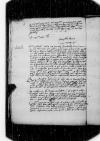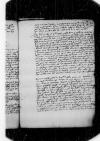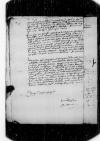Accepi superiori die ⌊⌋ Maiestatis Vestrae Serenissimae Cracoviae 1526-07-20⌊20 Iulii1526-07-20⌋ datas, quibus scribit, quod sibi ⌊⌋ meae 1526-05-13⌊13 Maii1526-05-13⌋ ex ⌊Hispali⌋ redditae fuerint. Ab eo tempore nullae ad me aliae perlatae sunt. ⌊⌋ et aliis Maiestatis Vestrae scriptis copiose cum familiari meo ⌊Fabiano⌋ 1526-09-01⌊prima Septembris1526-09-01⌋, 1526-09-12⌊121526-09-12⌋ et 1526-09-22⌊22 Octobris1526-09-22⌋ ⌊⌋, praesertim in his, quae Antonellum et expeditionem castri Barensis spectant. Addidit etiam in eisdem suis novissimis, quod magnificus dominus ⌊Lodvicus Alphius⌋ ad me super his scripsisset, habeoque coniecturam, quod fortassis illius litterae iunctae fuerant litteris Maiestatis Vestrae Serenissimae. Illae vero ad me non pervenerunt, de quo plurimum doleo, fuissent enim mihi non vulgariter gratae, ut pote cum iam diu ab ⌊eo⌋ nullas habuerim. Affectus sum nihilominus singulari gaudio, quod ⌊illum⌋ intelligo gratiam benemeritam Maiestatis Vestrae non amisisse, quam rebus et negotiis Maiestatis Vestrae Serenissimae fideliter inserviendo, uberiorem promeruit.
Quae adversus ⌊Lodovicum de Monte Alto⌋ et ⌊Hanibalem Baronum⌋, illius substitutum, expedivi, ⌊⌋, ad Maiestatem Vestram misso, et etiam ⌊⌋ ad Maiestatem Vestram datis, liquido intellexit. His Maiestas Vestra Serenissima, quae prudentissima est, suo tempore, quemadmodum res ipsa exposcere videbitur, commode utetur.
De consanguineo domini ⌊Sigismundi Loffredi⌋, cum ipse, praesente adhuc ⌊vicerege⌋, nihil hic desuper mecum ageret, me etiam continui, satius esse ducens, quod Maiestas Vestra Serenissima liberam castellani haberet electionem, quo aliquando ⌊castrum⌋ in omnimodam suam potestatem redig{et}eret, in quod velis, quantum fieri potest, erit incumbendum.
Citatione peremptoria, quam misi, non videretur mihi incommodum, quod Maiestas Vestra Serenissima quamprimum uteretur, quamdiu dominus ⌊Franciscus, olim Mediolani dux⌋, hostis ⌊caesaris⌋ censetur, ne, si forsan per tractatus cum ⌊Venetis⌋, qui illum tuentur, rediret in gratiam apud caesarem, difficiliores postea cum eo fierent actiones, et quanto citius haec citatio exsecutionem habebit, tanto securius et tranquillius ⌊Status Barensis⌋ conservabitur, salvo tamen meliori iudicio. Id ego hic secundum temporum qualitatem pro rudi meo intellectu assequor. Maiestas Vestra Serenissima, quae alias prudentissima est, nihil, quod ex re erit, omittet.
De litteris cambii, eum, quem cepi, modum servo per ⌊Welseros⌋ ad dominum ⌊Nicolaum Antonium Carminianum⌋, thesaurarium Maiestatis Vestrae. Multae hic exponuntur pecuniae, licet me, quantum possum et quantum cum ⌊Utriusque Maiestatis⌋ decoro convenit, contineam. Centum ducati per ordinarias pensas domus singulo quoque mense transeunt, raro per unum diem tribus ducatis dispensator domum sustinere potest, nihilque superflue profunditur, dummodo honeste, et aliis oratoribus inferioribus me non inferior videar. Sunt hic oratores, qui quolibet die 15 et 12 atque
<ad>
minus 9 ducatos exponunt, cum his tamen sic me gero, quod illis non impar habeor. Adhibenda est enim apud istas hic nationes aestimationis accurata ratio, quam hic ⌊utriusque Maiestatis Vestrae⌋ nomine nulla hactenus in re diminui; unde et extraordinarie non parum impenditur, de quibus prius aliquoties scripsi, et ad praesens etiam attingo, cum hic maiores quam ante in aliis civitatibus, ubi cum ⌊caesare⌋ egimus, expensas facere cogimur, lectosque et hospitia solvere, pro quibus hic extraordinarie per istos sex menses non infra 60 ducatos exponam, quid de reliquis, quod ad praesens recensere et longum et morosum esset. De his omnibus, Deo bene favente, calculi mei liquido respondebunt.
Et ne expensis Maiestatis Vestrae Serenissimae essem gravior, praesertim in extraordinariis, accepi, ut nuper scripsi, a ⌊Fuccaris⌋ 150 ducatos, qui ⌊Georgio Hegel⌋ ex proventibus meis Columbanis persolvi debent, et paulo ante iterum 50. Item cum huc missus a ⌊maiestate regia⌋ frater meus ⌊Bernardus⌋ cum litteris regiis appulisset et hoc infaustum novum de clade serenissimi ⌊Hungar[iae] regis⌋ perlatum huc fuisset, ne ordinariis Maiestatis Vestrae expensis derogaretur pro vestienda familia et me in hoc luctu, et pro expensis pro fratre meo factis, accepi a ⌊Fuccaris⌋ centum ducatos, et alios centum in usus meos, qui a ⌊maiestate regia⌋ exiguntur, et isti centum ducati in stipendio servitii equorum meorum defalcabuntur. Velim, quod adhuc alicubi haberem quicquam, quod servitio Maiestatis Vestrae Serenissimae impendere possem, ut saltem cum illius gratia, salva fide et honore meo, aliquando mihi daretur reditus. Aliud commodum ex hac mea legatione, et pro tantis laboribus, quos fideliter impendi et in quibus totus canui et senui, non spero, neque cupio. Quod hinc reliquum est, gratiae et aequitati atque incomparabili prudentiae Maiestatis Vestrae Serenissimae humiliter committo.
Accepi 1526-12-05⌊heri1526-12-05⌋ pro hoc in ⌊Valle Oleti⌋ itinere, quod plus quam centum milliaria nostra conficiet, a ⌊Welzeris⌋ iterum trecentos ducatos, de his paulo post extraordinariae pro equis et mulabus, quae res meas ducent, totam hic domum et quae ad eam spectant, non secus atque apud nos nobiscum hic circumferre cogimur, non parum exponetur, succedet subinde novus annus cum strenis, quem etiam vix 40 ducatis absolvam, sic semper extraordinaria accrescunt, unde maximo taedio afficior, cum tantam pecuniarum profusionem video, quae tamen sub ista persona, quam fero, vitari non potest. Velim itaque atque humillime supplico, cum iam fere omnia hic sunt expedita, quod Maiestas Vestra Serenissima me quantocius revocare dignaretur, reditusque mei clementem rationem habeat. Cum primum ⌊vicerex⌋ ⌊Neapolim⌋ applicuerit, negotium ⌊castri⌋ ad votum, ut spero, Maiestatis Vestrae Serenissimae terminabitur. De ⌊illo⌋ ab eo tempore, quo ex portu ⌊Carthaginis hic Novae⌋ solvit, ne verbum quidem auditur amplius. Magno cum desiderio a ⌊caesare⌋ nova de ⌊illo⌋ hic exspectantur.
Expedivi hic litteras ⌊caesaris⌋ ad ⌊collaterale consilium⌋, ut fiat omnimoda iustitia contra locum tenentem ⌊Alarconis⌋, de civibus his duobus Barensibus occisis. Rem ipsam cum affectu ⌊caesari⌋ exposui, quippe cum tam indignum sit facinus ab eo permissum, qui hoc reprimere et castigare debuisset. ⌊Caesar⌋ id certe aegerrime tulit iussitque desuper commissionem fieri, quae quidem scripta est, sed nondum manu caesaris firmata. Sic expediuntur hic negotia. Iam fere mensis est, quod adhuc has litteras a secretario habere non possum, spero tamen quod vel hodie, vel cras illas sum habiturus. Id si fiet, cum praesentibus mittentur.
De consanguineo Maiestatis Vestrae Serenissimae, illustrissimo domino ⌊duce Calabriae⌋, ⌊⌋ cum paenultimis ad ⌊maiestatem regiam⌋. Bonus iste ⌊princep⌋s, etiamsi vultur esset, satis habet cadaveris, duxit molem carneam immanem et ingentem, neque credo crassiorem hoc aevo haberi mulierem regina hac ⌊Germana⌋, quae non pinguis, sed ipsum abdomen dici potest. Cum ⌊illa⌋ ⌊Valentiae⌋ ex rege vicerex factus est, bene tamen sibi consuluit. Si ⌊hanc massam carneam⌋ non duxisset, adhuc esset in fictilibus, cum nunc aurum et argentum in usu habeat, quo prius omnino erat indigus.
Scripserat ad me superiore die dominus ⌊Scipio de Summa⌋, frater uterinus domini ⌊Sigismundi Loffredi⌋, quem generalem audientiarium ⌊Status Barensis⌋ Maiestas Vestra Serenissima constituit, quod fiscus a Maiestate Vestra Serenissima militare servitium, quod toti regno fuit indictum, ex Statu Barensi exegisset, ad quod de consuetudine Maiestas Vestra ex sanguine regio descendens non astringeretur, exemptaque semper fuisset illustrissima olim domina ⌊mater⌋ Maiestatis Vestrae, dum in vivis ageret. Qua de re ⌊maiestati caesareae⌋ supplicavi. A ⌊quo⌋ obtinui, si ex constitutionibus regni sic observatum fuisset, ne etiam quicquam Maiestati Vestrae derogaretur. Ad consuetudinem vero, quam allegavi, nihil impetrare potui, unde timeo, quod istae caesaris commissiones, quas illi misi duplicatas, parum proderint. Quid speremus in rebus gratiae cum adhuc in his, quae de iure et mera iustitia ad Maiestatem Vestram Serenissimam spectant, difficultatem habeamus.
Mittitur hinc ⌊Caesar Farramusca⌋ ad ⌊pontificis⌋ animum explorandum, si venturus sit certo in ⌊Hispaniam⌋ nec ne, quemadmodum ⌊maiestati caesareae⌋ perscripsit. Is nunc ⌊Caesar⌋ apud ⌊caesarem⌋ multa potest, et factus est magister stabuli, quod officium hic inter prima habetur. Sic fit. cf. Juv. 7.197 ⌊Si fortuna volet, fies de rhetore consul etc.cf. Juv. 7.197 ⌋
Exspecto adhuc responsum Maiestatis Vestrae Serenissimae de sobellis, si ipsi ⌊maiestati caesareae⌋, vel alteri cuipiam illos dari voluerit, et de mille ducatis ⌊magno cancellario⌋. Quicquid in his fieri decreverit, quemadmodum cum ⌊Fabiano⌋ scripsi et denuntiavi, et de omnibus aliis, mihi cum primis praecipiat. Ego me extra mandatum et voluntatem Maiestatis Vestrae Serenissimae ne latum quidem unguem efferam, et id semper, quod fidelis servi officium est, diligenter et fideliter observabo atque, quantum totis viribus eniti possum, complebo,
cf. Verg. A. 4.336 ⌊dum memor ipse mei, dum spiritus hos regit artuscf. Verg. A. 4.336 ⌋.
Fuit hic hactenus frater ⌊Marchus de Taranto⌋, theologiae professor, quem tantopere mihi magnificus dominus ⌊Ludovicus Aliphius⌋ superiori anno commendavit, et quem credidit hic posse plurima, quemadmodum iste bonus frater de se ipso iactare solet. ⌊Is⌋ iam absumptis pecuniis, et etiam quibusdam a me in mutu
<u>
m acceptis, quas visurus sum numquam, cum expeditionibus suis hinc in ⌊Italiam⌋ revertitur. Omnia, quae hic pro universitate Barensi, et in causa Rutilia[ni] ac Divi Nicolai obtinuit, ⌊Neapoli⌋ etiam obtinuisset, nam illic ad forum omnia remittuntur. Sic hic tract[atur].
Alia in hac temporis angustia, cum pro itinere sarcinulae sunt colligendae, non restant, ex ⌊Valledolit⌋ forsan latior scribendi {scribendi} dabitur campus, cum intellexe[ro], quid super novissimis commissionibus de ⌊castro Barensi⌋ a ⌊vicerege⌋ factum fuerit. Utinam ad eum modum transigat[ur] negotium, ut aliquando ex hoc exilio, seu potius ergastulo redire possim. Quod gratiae et voluntati Maiestatis Vestrae Serenissimae humiliter una mecum commendo, et rogo fratrem meum ⌊Georgium⌋ sic ubi me absente in ⌊Regno⌋ erret, in clientela[m] suam clementer suscipiat. Id semper cum hac vita, quamdiu in me erit, promereri studebo.




